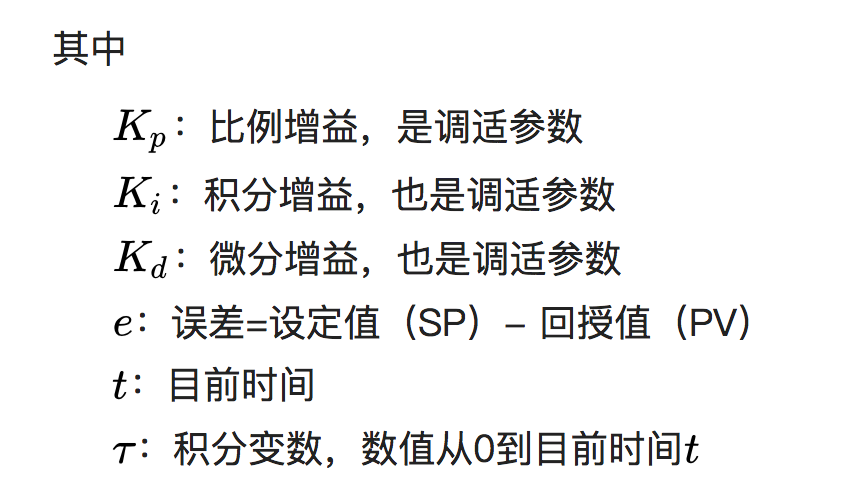Spark Streaming的PIDRateEstimator与backpressure
PIDRateEstimator是Spark Streaming用来实现backpressure的关键组件。
看了一些博客文章,感觉对它的解释都没有说到要点,还是自己来研究一下比较好。
首先,需要搞清楚的一个问题是Spark Streaming的backpressure是想让系统达到怎么样的一种状态。这个问题不明确,PIDRateEstimator的作用就搞不清楚。
backpressure的目标
首先,backpressure这套机制是系统(由应用程序和物理资源组成的整体)的内在性质对Spark Streaming的吞吐量的限制,而并非是某种优化。可以认为,在固定的资源下(CPU、内存、IO),Spark Streaming程序存在吞吐量的上限。
放在非micro-batch的情况下考虑,这意味着存在一个最大处理速度,RateEstimator认为这个速度的单位为records/second (不过实际上,每条消息的处理所耗的时间可能差别很大,所以这个速度的单位用records/second实际上是可能并不合适,可能是一种过度的简化)。
放在Spark Streaming的micro-batch的情况下,由于调度器每隔batch duration的时间间隔生成一个micro-batch,这个吞吐率的上限意味着每个batch总的消息数量存在上限。如果给每个batch分配率的消息总数超过这个上限,每秒处理消息条数是不变的,只会使得batch的处理时间延长,这样对于系统没有什么好处,反而由于每个batch太大而可能导致OOM。
当达到这个最大处理速度时,表现就是batch duration等于batch的计算阶段所花的时间,也就是batch duration == batch processing time。
那么backpressure的目标,就是使得系统达到上边这个状态(这个并非完全对,下面的分析会给出具体的状态)。它不会使得系统的累积未处理的数据减少,也不会使得系统的吞吐率提高(在不引起OOM,以及不计算GC的开销的情况下,当processing time > batch duration时,系统的吞吐量已经达到最高)。而只是使得系统的实际吞吐量稳定在最大吞吐量(除非你手动设置的rate的最大值小于最大吞吐量)
PIDRateEstimator
首先,要明确PID控制器的作用。
引用一篇blog的说法:
PID控制器是一个在工业控制应用中常见的反馈回路部件。
这个控制器把收集到的数据和一个参考值进行比较,然后把这个差别用于计算新的输入值,
这个新的输入值的目的是可以让系统的数据达到或者保持在参考值。
PID控制器可以根据历史数据和差别的出现率来调整输入值,使系统更加准确而稳定。
重点在于它的目的是调整输入,比而使得系统的某个我们关注的目标指标到目标值。
PID的控制输出的公式为

这里u(t)为PID的输出。

SP是setpoint, 就是参考值
PV是 process variable, 也就是测量值。
A PID controller continuously calculates an error value e(t) as the difference between a desired setpoint (SP) and a measured process variable (PV) and applies a correction based on proportional, integral, and derivative terms (denoted P, I, and D respectively), hence the name.
计算逻辑
首先,看下RateEstimator的compute方法的定义
private[streaming] trait RateEstimator extends Serializable {
/**
* Computes the number of records the stream attached to this `RateEstimator`
* should ingest per second, given an update on the size and completion
* times of the latest batch.
*
* @param time The timestamp of the current batch interval that just finished
* @param elements The number of records that were processed in this batch
* @param processingDelay The time in ms that took for the job to complete
* @param schedulingDelay The time in ms that the job spent in the scheduling queue
*/
def compute(
time: Long,
elements: Long,
processingDelay: Long,
schedulingDelay: Long): Option[Double]
}
看下参数的含义
- time: 从它的来源看,它来源于BatchInfo的processingEndTime, 准确含义是 “Clock time of when the last job of this batch finished processing”,也就是这个batch处理结束的时间
- elements: 这个batch处理的消息条数
- processingDelay: 这个job在实际计算阶段花的时间(不算调度延迟)
- schedulingDelay:这个job花在调度队列里的时间
PIDRateEstimator是获取当前这个结束的batch的数据,然后估计下一个batch的rate(注意,下一个batch并不一定跟当前结束的batch是连续两个batch,可能会有积压未处理的batch)。
PIDRateEstimator对于PID控制器里的"error"这个值是这么计算的:
// in seconds, should be close to batchDuration
val delaySinceUpdate = (time - latestTime).toDouble / 1000
// in elements/second
val processingRate = numElements.toDouble / processingDelay * 1000
// In our system `error` is the difference between the desired rate and the measured rate
// based on the latest batch information. We consider the desired rate to be latest rate,
// which is what this estimator calculated for the previous batch.
// in elements/second
val error = latestRate - processingRate
val historicalError = schedulingDelay.toDouble * processingRate / batchIntervalMillis
// in elements/(second ^ 2)
val dError = (error - latestError) / delaySinceUpdate
val newRate = (latestRate - proportional * error -
integral * historicalError -
derivative * dError).max(minRate)
这里的latestRate是指PID控制器为上一个batch,也就是当前结束的batch,在生成这个batch的时候估计的处理速度。
所以上边代码中,latestRate就是参考值, processingRate就是测量值。
这里为什么如此计算我还是没搞清楚,因为latestRate是一个变化的值,不知道这样在数学上会对后边的积分、微分项的含义造成什么影响。
error何时为0
可以推导出来当batchDuration = processingDelay时候,这里的error为零。
推导过程为:
latestRate实际上等于numElements / batchDuration,因为numElements是上次生成job时根据这个latestRate(也就是当时的estimated rate)算出来的。
那么 error = (numElements / batchDuaration) - (numElements/processingDelay) 这里的processingDelay就是processing time
所以,当processingDelay等于batchDuration时候,error为零。
但是error为零时,PID的输出不一定为零,因为需要考虑到历史误差和误差的变化。这里刚结束的batch可能并非生成后就立即被执行,而是在调度队列里排了一会队,所以还是需要考虑schedulingDelay,它反应了历史误差。
那么什么时候达到稳定状态呢?
当PID输出为0时,newRate就等于latestRate,此时系统达到了稳定状态,error为零,historicalError和dError都为0。
这意味着:
- 没有schedulingDelay,意味着job等待被调度的时间为0. 如果没有累积的未执行的job,那么schedulingDelay大致等于0.
- error为零,意味着batchDuration等于processingDelay
- dError为零,在error等于0时,意味着上一次计算的error也为零。
这就是整个RateEstimator,也就是backpressure想要系统达到的状态。
这里可以定性地分析一下达到稳定状态的过程:
- 如果batch分配的消息少于最高吞吐量,就会有processingRate > latestRate, 从而使得error为负,如果忽略积分和微分项的影响,就会使得newRate = latestRate - propotional * rate,从而使得newRate增大,因此下一个batch处理的消息会变多。
- 如果batch分配的消息大于最高吞吐量,就会有processingRate < latestRate,从而使得error为正,如果此前已经有job被积累,那么historicalError也为正,考虑到dError的系数默认为0,所以此时newRate = latestRate - proportional * error -integral * historicalError 使得newRate变小,从而使得下一个batch处理的消息变少,当newRate == latestRate时,有 -proportional * error == integral * historicalError,即error为一个负值,也即processingRate > latestRate,也就是说会使得给每个batch分配的消息小于它的最大处理量。此时,由于processingDelay小于batchDuration,会使得历史上累积的job有机会得到处理,从而逐渐减少在等待的job数量。
可以看出来这个PIDRateEstimator并非是普遍最优的,因为它的假设是系统的动态特定不随时间变化,但是实际上如果没有很有效的资源隔离,系统对于Spark Streaming程度来讲,其资源是随时间变化的,而且在某些时间可能发生剧烈的变化。此时,此时RateEstimator应该做出更剧烈的变化来应对,比如通过动态调整各个部分的系数。
如果用户对自己的系统有深的了解,比如当资源和负载是周期性变化时,那就可以定制更合适的RateEstimator,比如考虑到每天同比的流量变化来调整estimatedRate。





 浙公网安备 33010602011771号
浙公网安备 33010602011771号